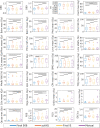Automated 4π radiotherapy treatment planning with evolving knowledge-base
- PMID: 31233619
- PMCID: PMC6739129
- DOI: 10.1002/mp.13682
Automated 4π radiotherapy treatment planning with evolving knowledge-base
Abstract
Purpose: Non-coplanar 4π radiotherapy generalizes intensity modulated radiation therapy (IMRT) to automate beam geometry selection but requires complicated hyperparameter tuning to attain superior plan quality, which can be tedious and inconsistent. In this study, a fully automated 4π treatment planning was developed using evolving knowledge-base (EKB) planning guided by dose prediction.
Methods: Twenty 4π lung and twenty 4π head and neck (HN) cases were included. A statistical voxel dose learning model was initially trained on low-quality plans created using generic hyperparameter templates without manual tuning. To improve the automated plan quality without being limited by the training data quality, a new 4π optimization problem was formulated to include a one-sided penalty on the organ-at-risk (OAR) dose deviation from the predicted dose. This directional OAR penalty encourages superior OAR sparing. The fast iterative shrinkage-thresholding algorithm (FISTA) was used to solve the large-scale beam orientation optimization problem. With the improved plans, new predictions were created to guide the next loop of EKB planning for a total of 10 loops. Plan quality was evaluated using a plan quality metric (PQM) points system based on clinical dose constraints and compared with automated planning approaches guided by manual high-quality plans using all non-coplanar beams, automated plans using individually evolved targeted dose, and manually created 4π plans.
Results: For the lung cases, the final EKB plans had significantly higher PQM than manually created 4π (+2.60%). The improvements plateaued after the third loop. The final HN EKB plans and manually created 4π plans had comparable PQMs, but had lower PQM compared to automated plans using a high-quality training set (-3.00% and -4.44%, respectively). The PQM consistently increased up to the sixth loop. Individually evolved plans were able to improve the plan quality from initial condition due to the one-sided cost function but the 60% of them were trapped in undesired local minima that were substantially worse than their corresponding EKB plans.
Conclusion: Evolving knowledge-base planning is a novel automated planning technique guided by the predicted three-dimensional dose distribution, which can evolve from low-quality plans. EKB allows new beams to be used in the automated planning workflow for superior plan quality.
Keywords: 4π; automated treatment planning; evolution.
© 2019 American Association of Physicists in Medicine.
Conflict of interest statement
The authors have no relevant conflicts of interest to disclose.
Figures








Similar articles
-
Integrated beam orientation and scanning-spot optimization in intensity-modulated proton therapy for brain and unilateral head and neck tumors.Med Phys. 2018 Apr;45(4):1338-1350. doi: 10.1002/mp.12788. Epub 2018 Mar 1. Med Phys. 2018. PMID: 29394454 Free PMC article.
-
Semiautomated head-and-neck IMRT planning using dose warping and scaling to robustly adapt plans in a knowledge database containing potentially suboptimal plans.Med Phys. 2015 Aug;42(8):4428-34. doi: 10.1118/1.4923174. Med Phys. 2015. PMID: 26233173
-
Treatment planning comparison of IMPT, VMAT and 4π radiotherapy for prostate cases.Radiat Oncol. 2017 Jan 11;12(1):10. doi: 10.1186/s13014-016-0761-0. Radiat Oncol. 2017. PMID: 28077128 Free PMC article.
-
Automated Plan Checking Software Demonstrates Continuous and Sustained Improvements in Safety and Quality: A 3-year Longitudinal Analysis.Pract Radiat Oncol. 2022 Mar-Apr;12(2):163-169. doi: 10.1016/j.prro.2021.09.014. Epub 2021 Oct 17. Pract Radiat Oncol. 2022. PMID: 34670137 Free PMC article. Review.
-
Barriers and facilitators to clinical implementation of radiotherapy treatment planning automation: A survey study of medical dosimetrists.J Appl Clin Med Phys. 2022 May;23(5):e13568. doi: 10.1002/acm2.13568. Epub 2022 Mar 3. J Appl Clin Med Phys. 2022. PMID: 35239234 Free PMC article. Review.
Cited by
-
Advances in Automated Treatment Planning.Semin Radiat Oncol. 2022 Oct;32(4):343-350. doi: 10.1016/j.semradonc.2022.06.004. Semin Radiat Oncol. 2022. PMID: 36202437 Free PMC article. Review.
-
Outcome-based multiobjective optimization of lymphoma radiation therapy plans.Br J Radiol. 2021 Nov 1;94(1127):20210303. doi: 10.1259/bjr.20210303. Epub 2021 Sep 30. Br J Radiol. 2021. PMID: 34541859 Free PMC article. Review.
-
Quantification of Dosimetry Improvement With or Without Patient Surface Guidance.Adv Radiat Oncol. 2024 Jul 14;9(9):101570. doi: 10.1016/j.adro.2024.101570. eCollection 2024 Sep. Adv Radiat Oncol. 2024. PMID: 39188998 Free PMC article.
-
A comparative study of deep learning-based knowledge-based planning methods for 3D dose distribution prediction of head and neck.J Appl Clin Med Phys. 2023 Sep;24(9):e14015. doi: 10.1002/acm2.14015. Epub 2023 May 3. J Appl Clin Med Phys. 2023. PMID: 37138549 Free PMC article.
-
Reformulated McNamara RBE-weighted beam orientation optimization for intensity modulated proton therapy.Med Phys. 2022 Apr;49(4):2136-2149. doi: 10.1002/mp.15552. Epub 2022 Mar 4. Med Phys. 2022. PMID: 35181892 Free PMC article.
References
-
- Appenzoller LM, Michalski JM, Thorstad WL, et al. Predicting dose‐volume histograms for organs‐at‐risk in IMRT planning. Med Phys. 2012;39:7446–7461. - PubMed
-
- Moore KL, Brame RS, Low DA, et al. Experience‐based quality control of clinical intensity‐modulated radiotherapy planning. Int J Radiat Oncol Biol Phys. 2011;81:545–541. - PubMed
-
- Nelms BE, Robinson G, Markham J, et al. Variation in external beam treatment plan quality: An inter‐institutional study of planners and planning systems. Pract Radiat Oncol. 2012;2:296–305. - PubMed
-
- Das IJ, Moskvin V, Johnstone PA. Analysis of treatment planning time among systems and planners for intensity‐modulated radiation therapy. J Am Coll Radiol. 2009;6:514–517. - PubMed
-
- Yuan L, Ge Y, Lee WR, et al. Quantitative analysis of the factors which affect the interpatient organ‐at‐risk dose sparing variation in IMRT plans. Med Phys. 2012;39:6868–78. - PubMed

